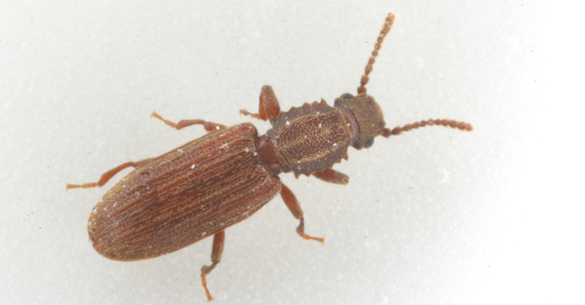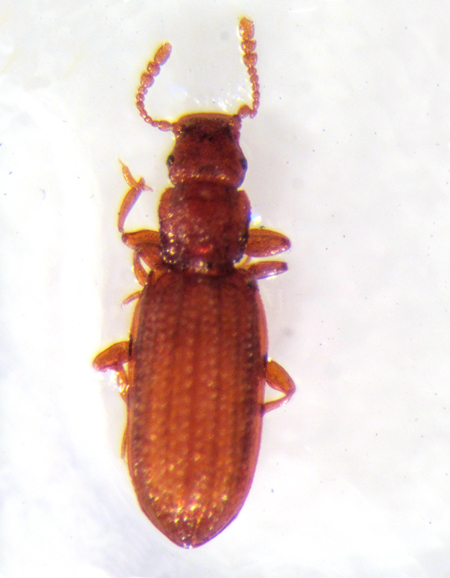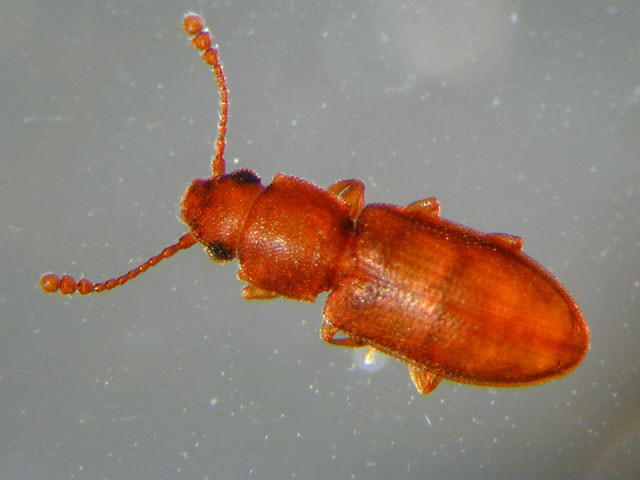Infestations of some insects are the direct result of moisture and accompanying mildews and fungi. Several insects are feeders on molds and mildews, or require the same high humidity conditions that favor mildew growth. Sometimes the presence of these insects provides a clue to water leaks or some other form of moisture problem.
The foreign grain beetle, Ahasverus advena, and several other tiny, fungus-feeding beetles, feed primarily on mildews and fungal spores. This insect, and other similar species listed below, sometimes become abundant indoors, especially in new homes. New homes often sustain mildew on newly installed lumber or sheet rock (gypsum board) that has absorbed water and produced mildew. These fungi provide a ready food source for several insects, resulting in (usually temporary) infestations. In older homes, foreign grain beetles are sometimes pests in bathrooms or other areas where high humidity permits growth and development of both the insects and their food.
Psocids (pronounced SO sidz), commonly called booklice, are not true lice. These minute insects feed on mildews and a variety of both plant- and animal-based foods such as dried fruit, flour, grains, cereal, dead insects, etc. Psocids depend on high humidity for reproduction and survival. They are most common in buildings and structures with excessive moisture or lack of air conditioning to maintain low humidity. They occur in books, rugs, foods and other items, especially if they are damp.
Identification

Psocid, or booklouse are minute, 1-2 mm-long. Note the bulging upper “lip”, narrow thorax and swollen hind femur.
Adult foreign grain beetles are minute (2-3 mm-long) with a flattened body and a squarish shield covering the thorax (pronotum). The pronotum is slightly wider than long when viewed from above. Color is reddish brown. The wing covers (elytra) are covered with rows of punctures and very fine hairs. Antennae are long, slightly less than half the body length, with a three-segmented club. The front corners of the pronotum project forward at a 45 degree angle. Other household insects of similar appearance, and with similar feeding habits, include the Lathridiidae beetles: the square necked grain beetle, Cathartus quadricollis, whose pronotum is longer than wide; the rusty and flat grain beetles, Cryptolestes spp. (with elongated antennae and lateral raised lines on each side of pronotum, parallel to margin); and the minute brown scavenger beetles,which have a pronotum that is often hairy and distinctly narrower than elytra and three-segmented tarsi. In addition, there are the silken fungus beetles (family Cryptophagidae) with a pronotum lacking prominent front corner angles and with punctures on the elytra not in rows.

Sawtoothed grain beetle is about 3 mm-long and has six, saw-like teeth on the neck (thorax) behind its head.
The merchant and sawtoothed grain beetles, Oryzaephilus spp., are more commonly found as pests of stored products, but can be distinguished by having 6 prominent tooth-like projections on either side of pronotum.
Psocids may also be common indoors. They are identified by their very small size (1 to 2 mm), pale coloration, and superficial resemblance (under high magnification) to termites. The common name booklouse comes from the fact that booklice are relatively easy to see on the pages of books, where they commonly feed on mildews growing on the paper (especially on books stored in attics or other non-air conditioned rooms).
Biology

The minute brown scavenger beetle, Dienerella (2 mm), is another common mildew feeder sometimes found in Texas homes.
Mildew feeders, like the foreign grain beetle, can become abundant in moist situations, especially where molds are present. Eggs are laid singly, or in clusters of 2-3, and hatch within 4-5 days. Females lay 1-4 eggs per day over a 20-30 day oviposition period. Life cycle from egg to adult requires an average of 22 days at 80° F (27°C) and 75% RH. Larvae require high humidities. Survival from larva to adult drops from 95% at 66-92% RH to zero survival at 66% RH in rolled oats. Both adults and larvae are capable of surviving on pure cultures of various molds. Foreign grain beetles are relatively long-lived, with mated males and females having average lifespans of 159 and 208 days, respectively.
Psocids require high humidity for survival and reproduction. Optimal conditions are 75% to 95% relative humidity and temperatures of 75° to 82° F (24° to 28° C). The average lifespan for one common species is about 25 days. Each female lays 50 to 60 eggs, and booklice are capable of rapid reproduction given good conditions.
Control
The best control for mildew-feeding insects is good sanitation, moisture reduction, and increased ventilation. Pesticides generally provide little control. However, wall voids infested with foreign grain beetle may be treated with appropriately labelled insecticides such as aerosol-formulated pyrethrins or insecticidal dusts. Infestations may be expected to persist until moisture levels are reduced to the point that molds or mildews cannot grow. In new homes with central air conditioning or heating, several weeks of drying out may be required before the infestation runs its course. There is no evidence that infestations will persist once moisture levels have dropped. Control of psocids can usually be obtained by reducing the relative humidity of infested areas to less than 58%.
For more information
For more information about stored product pests that may be confused with foreign grain beetle, request Extension publication E-486, Pantry and Fabric Pests in the Home.
Author:
Michael Merchant, Ph.D., Professor and Extension Urban Entomologist, Texas AgriLife Extension Service
